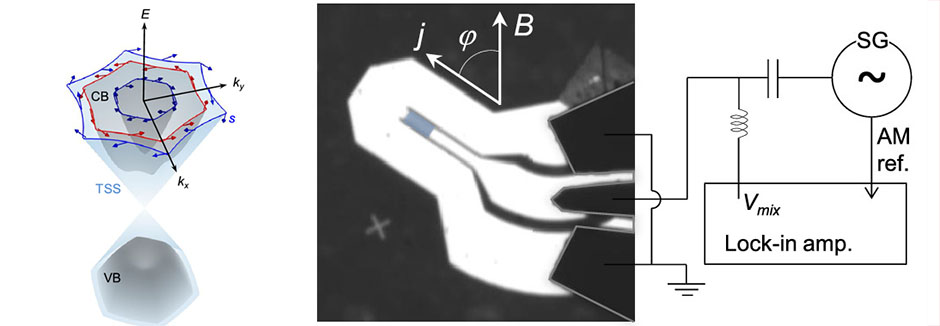Thursday, 01 October 2020
Interface engineering to control spin-orbit torques in topological insulator heterostructures
A group of scientists from the ICN2 Physics and Engineering of Nanodevices Group and Osaka University have demonstrated that intermixing in heterostructures plays a critical role in the generation of spin-orbit torques. Inserting a suitable normal metal spacer, material intermixing is reduced and the topological insulator properties at the interface are largely improved. The work is published in Nano Letters.

A topological insulator (TI) is a material that behaves as an insulator in its interior but whose surface contains exotic conducting states, thus allowing electrons to move only in the surface of the material. An interesting property of these surface electrons is that their spin is locked to the direction of motion, so that it can be manipulated by electrical currents. (Bi1−x Sbx)2Te3 topological insulators are gathering increasing attention owing to their large charge-to-spin conversion efficiency and the ensuing spin-orbit torques, a phenomenon that can be used to manipulate the magnetization of a ferromagnet (FM).
The origin of the torques, however, is not clear, as the hypotheses proposed so far have not succeeded in describing appropriately the phenomenon. On the other hand, the implications of hybridized states and the strong material intermixing at the TI/FM interface are essentially unexplored. The clarification of these interface effects in the interpretation of the observed torques is critical for the optimization of the spin-orbit torques and the application of TIs in magnetic memory technologies.
By combining interface chemical analysis and spin-transfer ferromagnetic resonance (ST-FMR) measurements, a group of scientists from the ICN2 Physics and Engineering of Nanodevices Group and Osaka University have demonstrated that intermixing plays a critical role in the generation of spin-orbit torques. By inserting a suitable normal metal spacer, material intermixing is reduced and the TI properties at the interface are largely improved, resulting in strong variations in the nature of the spin-orbit torques. These results are discussed in a paper in Nano Letters whose first and last authors are, respectively, Frédéric Bonell and ICN2 Group Leader ICREA Prof. Sergio O. Valenzuela. This research is related to the ERC Proof of Concept grant that was awarded to the aforementioned Group Leader, with the project “Topological-Insulator Based Spin Orbit Torque MEMories (SOTMEM), which aims to reduce power consumption in magnetic memories by incorporating topological insulators.
The researchers have shown that the metal spacers, with variable thickness, modify the degree of intermixing and that, when the intermixing is suppressed, a field-like torque is considerably enhanced. Controlling the effect of these deviations from an ideal TI/metal interface provides a strategy to engineer TI/Normal Metal/Permalloy heterostructures and to achieve efficient manipulation of magnetic devices. Metallic spacers represent an effective way to reduce intermixing, and the spin memory loss, by preventing tellurium from diffusing out of the TI. Further engineering of the multilayers could help isolate the contribution of topological surface states, opening new perspectives to optimize the spin-orbit torques in topological insulator heterostructures. These phenomena can play a relevant role at other interfaces, such as those comprising transition metal dichalcogenides.
Article reference:
Frédéric Bonell, Minori Goto, Guillaume Sauthier, Juan F. Sierra, Adriana I. Figueroa, Marius V. Costache, Shinji Miwa, Yoshishige Suzuki, and Sergio O. Valenzuela. Control of Spin–Orbit Torques by Interface Engineering in Topological Insulator Heterostructures. Nano Lett. 2020, 20, 8, 5893–5899. https://doi.org/10.1021/acs.nanolett.0c01850

